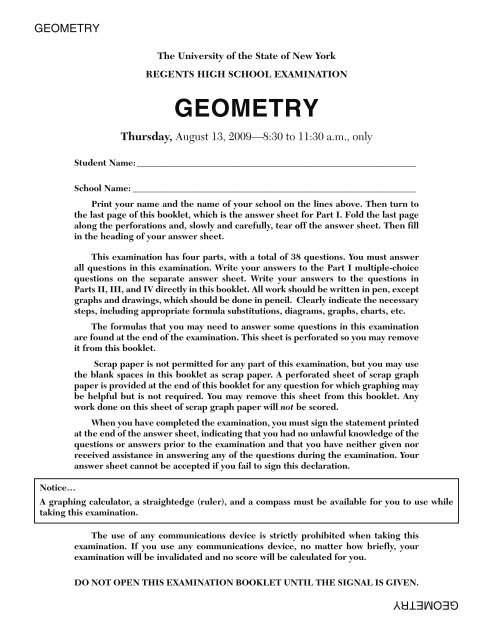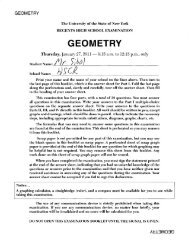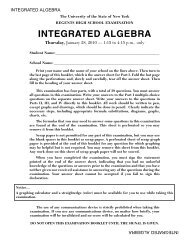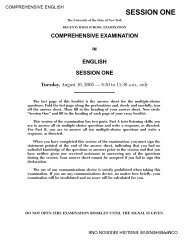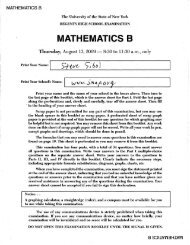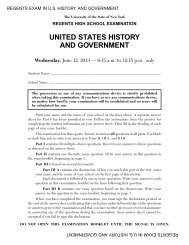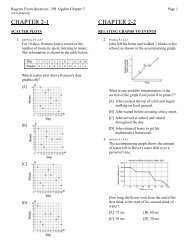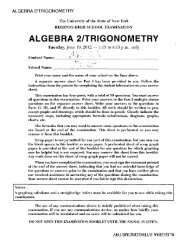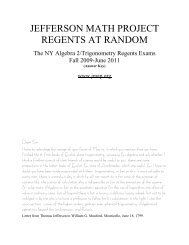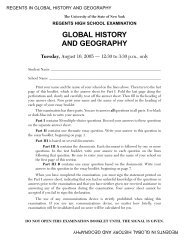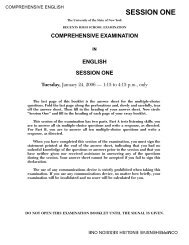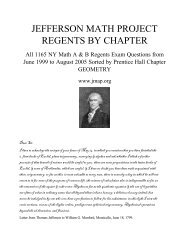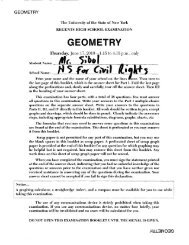GEOMETRY - JMap
GEOMETRY - JMap
GEOMETRY - JMap
Create successful ePaper yourself
Turn your PDF publications into a flip-book with our unique Google optimized e-Paper software.
<strong>GEOMETRY</strong><br />
The University of the State of New York<br />
REGENTS HIGH SCHOOL EXAMINATION<br />
<strong>GEOMETRY</strong><br />
Thursday, August 13, 2009—8:30 to 11:30 a.m., only<br />
Student Name: ______________________________________________________________<br />
School Name: _______________________________________________________________<br />
Print your name and the name of your school on the lines above. Then turn to<br />
the last page of this booklet, which is the answer sheet for Part I. Fold the last page<br />
along the perforations and, slowly and carefully, tear off the answer sheet. Then fill<br />
in the heading of your answer sheet.<br />
This examination has four parts, with a total of 38 questions. You must answer<br />
all questions in this examination. Write your answers to the Part I multiple-choice<br />
questions on the separate answer sheet. Write your answers to the questions in<br />
Parts II, III, and IV directly in this booklet. All work should be written in pen, except<br />
graphs and drawings, which should be done in pencil. Clearly indicate the necessary<br />
steps, including appropriate formula substitutions, diagrams, graphs, charts, etc.<br />
The formulas that you may need to answer some questions in this examination<br />
are found at the end of the examination. This sheet is perforated so you may remove<br />
it from this booklet.<br />
Scrap paper is not permitted for any part of this examination, but you may use<br />
the blank spaces in this booklet as scrap paper. A perforated sheet of scrap graph<br />
paper is provided at the end of this booklet for any question for which graphing may<br />
be helpful but is not required. You may remove this sheet from this booklet. Any<br />
work done on this sheet of scrap graph paper will not be scored.<br />
When you have completed the examination, you must sign the statement printed<br />
at the end of the answer sheet, indicating that you had no unlawful knowledge of the<br />
questions or answers prior to the examination and that you have neither given nor<br />
received assistance in answering any of the questions during the examination. Your<br />
answer sheet cannot be accepted if you fail to sign this declaration.<br />
Notice…<br />
A graphing calculator, a straightedge (ruler), and a compass must be available for you to use while<br />
taking this examination.<br />
The use of any communications device is strictly prohibited when taking this<br />
examination. If you use any communications device, no matter how briefly, your<br />
examination will be invalidated and no score will be calculated for you.<br />
DO NOT OPEN THIS EXAMINATION BOOKLET UNTIL THE SIGNAL IS GIVEN.<br />
<strong>GEOMETRY</strong>
Part I<br />
Answer all 28 questions in this part. Each correct answer will receive 2 credits. No partial<br />
credit will be allowed. For each question, write on the separate answer sheet the numeral<br />
preceding the word or expression that best completes the statement or answers the question.<br />
[56]<br />
Use this space for<br />
1 Based on the diagram below, which statement is true?<br />
computations.<br />
a<br />
b<br />
c<br />
110°<br />
60°<br />
115°<br />
d<br />
120°<br />
e<br />
(1) a b (3) b c<br />
(2) a c (4) d e<br />
2 The diagram below shows the construction of the bisector of ∠ABC.<br />
A<br />
D<br />
F<br />
B<br />
Which statement is not true?<br />
(1) m∠EBF = 1 __<br />
2 m∠ABC<br />
(2) m∠DBF = 1 __<br />
2 m∠ABC<br />
(3) m∠EBF = m∠ABC<br />
(4) m∠DBF = m∠EBF<br />
E<br />
C<br />
Geometry – August ’09 [2]
3 In the diagram of △ABC below, _ AB ≅ _ AC . The measure of ∠B<br />
is 40°.<br />
Use this space for<br />
computations.<br />
B<br />
A<br />
C<br />
What is the measure of ∠A?<br />
(1) 40° (3) 70°<br />
(2) 50° (4) 100°<br />
4 In the diagram ) of circle O below, chord CD _ _<br />
is parallel to diameter<br />
AOB and m AC = 30.<br />
C<br />
D<br />
A<br />
O<br />
B<br />
What is m ) CD ?<br />
(1) 150 (3) 100<br />
(2) 120 (4) 60<br />
Geometry – August ’09 [3] [OVER]
5 In the diagram of trapezoid ABCD below, diagonals _ AC and _ BD<br />
intersect at E and △ABC ≅ △DCB.<br />
Use this space for<br />
computations.<br />
C<br />
B<br />
E<br />
D<br />
A<br />
Which statement is true based on the given information?<br />
(1) AC _ ≅ BC _ (3) ∠CDE ≅ ∠BAD<br />
(2) CD _ ≅ AD _ (4) ∠CDB ≅ ∠BAC<br />
6 Which transformation produces a figure similar but not congruent to<br />
the original figure?<br />
(1) T 1,3<br />
(3) R 90°<br />
(2) D 1__<br />
2<br />
(4) r y = x<br />
7 In the diagram below of parallelogram ABCD with diagonals _ AC and<br />
_<br />
BD , m∠1 = 45 and m∠DCB = 120.<br />
A<br />
B<br />
D<br />
1<br />
2<br />
C<br />
What is the measure of ∠2?<br />
(1) 15° (3) 45°<br />
(2) 30° (4) 60°<br />
Geometry – August ’09 [4]
8 On the set of axes below, Geoff drew rectangle ABCD. He will<br />
transform the rectangle by using the translation (x,y) (x + 2,y + 1)<br />
and then will reflect the translated rectangle over the x-axis.<br />
Use this space for<br />
computations.<br />
y<br />
D<br />
C<br />
A<br />
B<br />
x<br />
What will be the area of the rectangle after these transformations?<br />
(1) exactly 28 square units<br />
(2) less than 28 square units<br />
(3) greater than 28 square units<br />
(4) It cannot be determined from the information given.<br />
9 What is the equation of a line that is parallel to the line whose equation<br />
is y = x + 2?<br />
(1) x + y = 5 (3) y − x = −1<br />
(2) 2x + y = −2 (4) y − 2x = 3<br />
10 The endpoints of _ CD are C(−2,−4) and D(6,2). What are the<br />
coordinates of the midpoint of _ CD ?<br />
(1) (2,3) (3) (4,−2)<br />
(2) (2,−1) (4) (4,3)<br />
Geometry – August ’09 [5] [OVER]
11 What are the center and the radius of the circle whose equation is<br />
(x − 3) 2 + (y + 3) 2 = 36?<br />
(1) center = (3,−3); radius = 6<br />
(2) center = (−3,3); radius = 6<br />
(3) center = (3,−3); radius = 36<br />
(4) center = (−3,3); radius = 36<br />
Use this space for<br />
computations.<br />
12 Given the equations:<br />
y = x 2 − 6x + 10<br />
y + x = 4<br />
What is the solution to the given system of equations?<br />
(1) (2,3) (3) (2,2) and (1,3)<br />
(2) (3,2) (4) (2,2) and (3,1)<br />
13 The diagonal _ AC is drawn in parallelogram ABCD. Which method<br />
can not be used to prove that △ABC ≅ △CDA?<br />
(1) SSS (3) SSA<br />
(2) SAS (4) ASA<br />
Geometry – August ’09 [6]
14 In the diagram below, line k is perpendicular to plane P at point T.<br />
Use this space for<br />
computations.<br />
k<br />
T<br />
Which statement is true?<br />
(1) Any point in plane P also will be on line k.<br />
(2) Only one line in plane P will intersect line k.<br />
(3) All planes that intersect plane P will pass through T.<br />
(4) Any plane containing line k is perpendicular to plane P.<br />
15 In the diagram below, which transformation was used to map △ABC<br />
to △A′B′C′?<br />
A<br />
C<br />
C′<br />
B<br />
B′<br />
A′<br />
(1) dilation (3) reflection<br />
(2) rotation (4) glide reflection<br />
Geometry – August ’09 [7] [OVER]
16 Which set of numbers represents the lengths of the sides of a<br />
triangle?<br />
(1) {5, 18, 13} (3) {16, 24, 7}<br />
(2) {6, 17, 22} (4) {26, 8, 15}<br />
Use this space for<br />
computations.<br />
17 What is the slope of a line perpendicular to the line whose equation<br />
is y = −<br />
2__<br />
3 x − 5?<br />
(1) −<br />
3__<br />
2<br />
(2) −<br />
2__<br />
3<br />
(3) 2__<br />
3<br />
(4) 3__<br />
2<br />
18 A quadrilateral whose diagonals bisect each other and are<br />
perpendicular is a<br />
(1) rhombus (3) trapezoid<br />
(2) rectangle (4) parallelogram<br />
19 If the endpoints of AB _ are A(−4,5) and B(2,−5), what is the<br />
length of AB _ ?<br />
(1) 2 √ ___<br />
34 (3) √ ___<br />
61<br />
(2) 2 (4) 8<br />
Geometry – August ’09 [8]
20 In the diagram below of △ACT, D is the midpoint of _ AC , O is the<br />
midpoint of _ AT , and G is the midpoint of _ CT .<br />
Use this space for<br />
computations.<br />
A<br />
D<br />
O<br />
C G T<br />
If AC = 10, AT = 18, and CT = 22, what is the perimeter of<br />
parallelogram CDOG ?<br />
(1) 21 (3) 32<br />
(2) 25 (4) 40<br />
21 Which equation represents circle K shown in the graph below?<br />
y<br />
K<br />
6<br />
5<br />
4<br />
3<br />
2<br />
1<br />
–9 –8 –7 –6 –5 –4 –3 –2 –1<br />
–1<br />
–2<br />
–3<br />
–4<br />
–5<br />
–6<br />
1 2 3<br />
x<br />
(1) (x + 5) 2 + (y − 1) 2 = 3 (3) (x − 5) 2 + (y + 1) 2 = 3<br />
(2) (x + 5) 2 + (y − 1) 2 = 9 (4) (x − 5) 2 + (y + 1) 2 = 9<br />
Geometry – August ’09 [9] [OVER]
22 In the diagram below of right triangle ACB, altitude _ CD is drawn to<br />
hypotenuse _ AB .<br />
Use this space for<br />
computations.<br />
C<br />
12<br />
A<br />
D<br />
36<br />
B<br />
If AB = 36 and AC = 12, what is the length of AD _ ?<br />
(1) 32 (3) 3<br />
(2) 6 (4) 4<br />
23 In the diagram of circle O below, chord _ AB intersects chord _ CD at E,<br />
DE = 2x + 8, EC = 3, AE = 4x − 3, and EB = 4.<br />
D<br />
A<br />
O<br />
E<br />
B<br />
C<br />
What is the value of x?<br />
(1) 1 (3) 5<br />
(2) 3.6 (4) 10.25<br />
24 What is the negation of the statement “Squares are parallelograms”?<br />
(1) Parallelograms are squares.<br />
(2) Parallelograms are not squares.<br />
(3) It is not the case that squares are parallelograms.<br />
(4) It is not the case that parallelograms are squares.<br />
Geometry – August ’09 [10]
25 The diagram below shows the construction of the center of the circle<br />
circumscribed about △ABC.<br />
Use this space for<br />
computations.<br />
B<br />
C<br />
A<br />
This construction represents how to find the intersection of<br />
(1) the angle bisectors of △ABC<br />
(2) the medians to the sides of △ABC<br />
(3) the altitudes to the sides of △ABC<br />
(4) the perpendicular bisectors of the sides of △ABC<br />
26 A right circular cylinder has a volume of 1,000 cubic inches and a<br />
height of 8 inches. What is the radius of the cylinder to the nearest<br />
tenth of an inch?<br />
(1) 6.3 (3) 19.8<br />
(2) 11.2 (4) 39.8<br />
27 If two different lines are perpendicular to the same plane, they are<br />
(1) collinear (3) congruent<br />
(2) coplanar (4) consecutive<br />
Geometry – August ’09 [11] [OVER]
28 How many common tangent lines can be drawn to the two externally<br />
tangent circles shown below?<br />
Use this space for<br />
computations.<br />
(1) 1 (3) 3<br />
(2) 2 (4) 4<br />
Geometry – August ’09 [12]
Part II<br />
Answer all 6 questions in this part. Each correct answer will receive 2 credits. Clearly<br />
indicate the necessary steps, including appropriate formula substitutions, diagrams, graphs,<br />
charts, etc. For all questions in this part, a correct numerical answer with no work shown will<br />
receive only 1 credit. All answers should be written in pen, except for graphs and drawings,<br />
which should be done in pencil. [12]<br />
29 In the diagram below of isosceles trapezoid DEFG, _ DE _ GF , DE = 4x − 2, EF = 3x + 2,<br />
FG = 5x − 3, and GD = 2x + 5. Find the value of x.<br />
D<br />
4x – 2<br />
E<br />
2x + 5<br />
3x + 2<br />
G 5x – 3<br />
F<br />
Geometry – August ’09 [13] [OVER]
30 A regular pyramid with a square base is shown in the diagram below.<br />
h<br />
s<br />
A side, s, of the base of the pyramid is 12 meters, and the height, h, is 42 meters. What is the<br />
volume of the pyramid in cubic meters?<br />
Geometry – August ’09 [14]
31 Write an equation of the line that passes through the point (6,−5) and is parallel to the line whose<br />
equation is 2x − 3y = 11.<br />
Geometry – August ’09 [15] [OVER]
32 Using a compass and straightedge, construct the angle bisector of ∠ABC shown below. [Leave all<br />
construction marks.]<br />
C<br />
A<br />
B<br />
Geometry – August ’09 [16]
33 The degree measures of the angles of △ABC are represented by x, 3x, and 5x − 54.<br />
Find the value of x.<br />
Geometry – August ’09 [17] [OVER]
34 In the diagram below of △ABC with side _ AC extended through D, m∠A = 37 and m∠BCD = 117.<br />
Which side of △ABC is the longest side? Justify your answer.<br />
B<br />
A<br />
37°<br />
117°<br />
C<br />
D<br />
(Not drawn to scale)<br />
Geometry – August ’09 [18]
Part III<br />
Answer all 3 questions in this part. Each correct answer will receive 4 credits. Clearly<br />
indicate the necessary steps, including appropriate formula substitutions, diagrams, graphs,<br />
charts, etc. For all questions in this part, a correct numerical answer with no work shown will<br />
receive only 1 credit. All answers should be written in pen, except for graphs and drawings,<br />
which should be done in pencil. [12]<br />
35 Write an equation of the perpendicular bisector of the line segment whose endpoints are (−1,1)<br />
and (7,−5). [The use of the grid below is optional.]<br />
Geometry – August ’09 [19] [OVER]
36 On the set of axes below, sketch the points that are 5 units from the origin and sketch the points<br />
that are 2 units from the line y = 3. Label with an X all points that satisfy both conditions.<br />
y<br />
x<br />
Geometry – August ’09 [20]
37 Triangle DEG has the coordinates D(1,1), E(5,1), and G(5,4). Triangle DEG is rotated 90° about<br />
the origin to form △D′E′G′. On the grid below, graph and label △DEG and △D′E′G′. State the<br />
coordinates of the vertices D′, E′, and G′. Justify that this transformation preserves distance.<br />
Geometry – August ’09 [21] [OVER]
Part IV<br />
Answer the question in this part. A correct answer will receive 6 credits. Clearly indicate<br />
the necessary steps, including appropriate formula substitutions, diagrams, graphs, charts, etc.<br />
A correct numerical answer with no work shown will receive only 1 credit. The answer should<br />
be written in pen. [6]<br />
38 Given: Quadrilateral ABCD, diagonal _ AFEC , _ AE ≅ _ FC , _ BF ⊥ _ AC , _ DE ⊥ _ AC , ∠1 ≅ ∠2<br />
Prove: ABCD is a parallelogram.<br />
B<br />
C<br />
1<br />
E<br />
F<br />
2<br />
A<br />
D<br />
Geometry – August ’09 [22]
Reference Sheet<br />
Tear Here<br />
Tear Here<br />
Cylinder<br />
V Bh<br />
where B is the area of the base<br />
Volume<br />
Pyramid<br />
Right Circular Cone<br />
V <br />
1<br />
–Bh<br />
3<br />
where B is the area of the base<br />
V <br />
1<br />
–Bh<br />
3<br />
where B is the area of the base<br />
Sphere<br />
V <br />
4<br />
–r<br />
3<br />
3<br />
Lateral Area (L)<br />
Right Circular Cylinder<br />
Right Circular Cone<br />
L 2rh<br />
L rl<br />
where l is the slant height<br />
Surface Area<br />
Sphere<br />
SA 4r 2<br />
Geometry – August ’09 [23]
Tear Here<br />
Tear Here
Scrap Graph Paper — This sheet will not be scored.<br />
Tear Here<br />
Tear Here
Scrap Graph Paper — This sheet will not be scored.<br />
Tear Here<br />
Tear Here
The University of the State of New York<br />
REGENTS HIGH SCHOOL EXAMINATION<br />
<strong>GEOMETRY</strong><br />
Tear Here<br />
Thursday, August 13, 2009—8:30 to 11:30 a.m., only<br />
ANSWER SHEET<br />
Student . . . . . . . . . . . . . . . . . . . . . . . . . . . . . . . . . . . . . . . . Sex: ❑ Male ❑ Female Grade . . . . . .<br />
Teacher . . . . . . . . . . . . . . . . . . . . . . . . . . . . . . . . . . . . . . . . School . . . . . . . . . . . . . . . . . . . . . . . . . . . . .<br />
Your answers to Part I should be recorded on this answer sheet.<br />
Part I<br />
Answer all 28 questions in this part.<br />
1 . . . . . . . . . . . . . . . .<br />
8 . . . . . . . . . . . . . . . .<br />
15 . . . . . . . . . . . . . . . .<br />
22 . . . . . . . . . . . . . . . .<br />
2 . . . . . . . . . . . . . . . .<br />
9 . . . . . . . . . . . . . . .<br />
16 . . . . . . . . . . . . . . . .<br />
23 . . . . . . . . . . . . . . . .<br />
3 . . . . . . . . . . . . . . . .<br />
10 . . . . . . . . . . . . . . . .<br />
17 . . . . . . . . . . . . . . .<br />
24 . . . . . . . . . . . . . . . .<br />
4 . . . . . . . . . . . . . . . .<br />
11 . . . . . . . . . . . . . . . .<br />
18 . . . . . . . . . . . . . . . .<br />
25 . . . . . . . . . . . . . . .<br />
5 . . . . . . . . . . . . . . . .<br />
12 . . . . . . . . . . . . . . . .<br />
19 . . . . . . . . . . . . . . . .<br />
26 . . . . . . . . . . . . . . . .<br />
6 . . . . . . . . . . . . . . . .<br />
13 . . . . . . . . . . . . . . . .<br />
20 . . . . . . . . . . . . . . . .<br />
27 . . . . . . . . . . . . . . . .<br />
7 . . . . . . . . . . . . . . . .<br />
14 . . . . . . . . . . . . . . . .<br />
21 . . . . . . . . . . . . . . . .<br />
28 . . . . . . . . . . . . . . . .<br />
Your answers for Parts II, III, and IV should be written in the test booklet.<br />
The declaration below should be signed when you have completed the examination.<br />
Tear Here<br />
I do hereby affirm, at the close of this examination, that I had no unlawful knowledge of the questions or answers prior to the<br />
examination and that I have neither given nor received assistance in answering any of the questions during the examination.<br />
Signature<br />
Geometry – August ’09 [27]
<strong>GEOMETRY</strong><br />
Rater’s/Scorer’s Name<br />
(minimum of three)<br />
<strong>GEOMETRY</strong><br />
Question<br />
Maximum<br />
Credit<br />
Part I 1–28 56<br />
Part II 29 2<br />
30 2<br />
31 2<br />
32 2<br />
33 2<br />
34 2<br />
Part III 35 4<br />
36 4<br />
37 4<br />
Part IV 38 6<br />
Maximum<br />
Total<br />
86<br />
Credits<br />
Earned<br />
Total Raw<br />
Score<br />
Rater’s/Scorer’s<br />
Initials<br />
Checked by<br />
Scaled Score<br />
(from conversion chart)<br />
Tear Here Tear Here<br />
Geometry – August ’09 [28]<br />
<strong>GEOMETRY</strong>
FOR TEACHERS ONLY<br />
The University of the State of New York<br />
REGENTS HIGH SCHOOL EXAMINATION<br />
<strong>GEOMETRY</strong><br />
Thursday, August 13, 2009 — 8:30 to 11:30 a.m., only<br />
SCORING KEY AND RATING GUIDE<br />
Mechanics of R ating<br />
The following procedures are to be followed for scoring student answer papers for the<br />
Regents Examination in Geometry. More detailed information about scoring is provided in<br />
the publication Information Booklet for Scoring the Regents Examination in Geometry.<br />
Use only red ink or red pencil in rating Regents papers. Do not attempt to correct the<br />
student’s work by making insertions or changes of any kind. Use check marks to indicate<br />
student errors.<br />
Unless otherwise specified, mathematically correct variations in the answers will be<br />
allowed. Units need not be given when the wording of the questions allows such omissions.<br />
Each student’s answer paper is to be scored by a minimum of three mathematics<br />
teachers. On the back of the student’s detachable answer sheet, raters must enter their initials<br />
in the boxes next to the questions they have scored and also write their name in the box under<br />
the heading “Rater’s/Scorer’s Name.”<br />
Raters should record the student’s scores for all questions and the total raw score on<br />
the student’s detachable answer sheet. Then the student’s total raw score should be converted<br />
to a scaled score by using the conversion chart that will be posted on the Department’s web<br />
site http://www.emsc.nysed.gov/osa/ on Thursday, August 13, 2009. The student’s scaled score<br />
should be entered in the box provided on the student’s detachable answer sheet. The scaled<br />
score is the student’s final examination score.
<strong>GEOMETRY</strong> – continued<br />
Part I<br />
Allow a total of 56 credits, 2 credits for each of the following. Allow credit if the<br />
student has written the correct answer instead of the numeral 1, 2, 3, or 4.<br />
(1) 4 (8) 1 (15) 4 (22) 4<br />
(2) 3 (9) 3 (16) 2 (23) 2<br />
(3) 4 (10) 2 (17) 4 (24) 3<br />
(4) 2 (11) 1 (18) 1 (25) 4<br />
(5) 4 (12) 4 (19) 1 (26) 1<br />
(6) 2 (13) 3 (20) 3 (27) 2<br />
(7) 1 (14) 4 (21) 2 (28) 3<br />
[2]
<strong>GEOMETRY</strong> – continued<br />
Updated information regarding the rating of this examination may be posted on the New York State<br />
Education Department’s website during the rating period. Check this web site<br />
http://www.emsc.nysed.gov/osa/ and select the link “Examination Scoring Information” for any recently<br />
posted information regarding this examination. This site should be checked before the rating process for this<br />
examination begins and several times throughout the Regents examination period.<br />
General Rules for Applying Mathematics Rubrics<br />
I. General Principles for Rating<br />
The rubrics for the constructed-response questions on the Regents Examinations in Geometry are designed to provide a<br />
systematic, consistent method for awarding credit. The rubrics are not to be considered all-inclusive; it is impossible to<br />
anticipate all the different methods that students might use to solve a given problem. Each response must be rated carefully<br />
using the teacher’s professional judgment and knowledge of mathematics; all calculations must be checked. The specific<br />
rubrics for each question must be applied consistently to all responses. In cases that are not specifically addressed in the<br />
rubrics, raters must follow the general rating guidelines in the publication Information Booklet for Scoring the Regents<br />
Examination in Geometry, use their own professional judgment, confer with other mathematics teachers, and/or contact the<br />
consultants at the State Education Department for guidance. During each Regents examination administration period, rating<br />
questions may be referred directly to the Education Department. The contact numbers are sent to all schools before each<br />
administration period.<br />
II. Full-Credit Responses<br />
A full-credit response provides a complete and correct answer to all parts of the question. Sufficient work is shown to enable<br />
the rater to determine how the student arrived at the correct answer.<br />
When the rubric for the full-credit response includes one or more examples of an acceptable method for solving the question<br />
(usually introduced by the phrase “such as”), it does not mean that there are no additional acceptable methods of arriving at the<br />
correct answer. Unless otherwise specified, mathematically correct alternative solutions should be awarded credit. The only<br />
exceptions are those questions that specify the type of solution that must be used; e.g., an algebraic solution or a graphic<br />
solution. A correct solution using a method other than the one specified is awarded half the credit of a correct solution using<br />
the specified method.<br />
III. Ap propriate Work<br />
Full-Credit Responses: The directions in the examination booklet for all the constructed-response questions state: “Clearly<br />
indicate the necessary steps, including appropriate formula substitutions, diagrams, graphs, charts, etc.” The student has the<br />
responsibility of providing the correct answer an d showing how that answer was obtained. The student must “construct” the<br />
response; the teacher should not have to search through a group of seemingly random calculations scribbled on the student<br />
paper to ascertain what method the student may have used.<br />
Responses With Errors: Rubrics that state “Appropriate work is shown, but …” are intended to be used with solutions that<br />
show an essentially complete response to the question but contain certain types of errors, whether computational, rounding,<br />
graphing, or conceptual. If the response is incomplete; i.e., an equation is written but not solved or an equation is solved but<br />
not all of the parts of the question are answered, appropriate work has not been shown. Other rubrics address incomplete<br />
responses.<br />
IV. Multiple Errors<br />
Computational Errors, Graphing Errors, and Rounding Errors: Each of these types of errors results in a 1-credit deduction.<br />
Any combination of two of these types of errors results in a 2-credit deduction. No more than 2 credits should be deducted for<br />
such mechanical errors in any response. The teacher must carefully review the student’s work to determine what errors were<br />
made and what type of errors they were.<br />
Conceptual Errors: A conceptual error involves a more serious lack of knowledge or procedure. Examples of conceptual<br />
errors include using the incorrect formula for the area of a figure, choosing the incorrect trigonometric function, or<br />
multiplying the exponents instead of adding them when multiplying terms with exponents. A response with one conceptual<br />
error can receive no more than half credit.<br />
If a response shows repeated occurrences of the same conceptual error, the student should not be penalized twice. If the same<br />
conceptual error is repeated in responses to other questions, credit should be deducted in each response.<br />
If a response shows two (or more) different major conceptual errors, it should be considered completely incorrect and<br />
receive no credit.<br />
If a response shows one conceptual error and one computational, graphing, or rounding error, the teacher must award credit<br />
that takes into account both errors; i.e., awarding half credit for the conceptual error and deducting 1 credit for each<br />
mechanical error (maximum of two deductions for mechanical errors).<br />
[3] [OVER]
<strong>GEOMETRY</strong> – continued<br />
Part II<br />
For each question, use the specific criteria to award a maximum of two credits. Unless<br />
otherwise specified, mathematically correct alternative solutions should be awarded<br />
appropriate credit.<br />
(29) [2] 3, and appropriate work is shown.<br />
[1] Appropriate work is shown, but one computational error is made.<br />
or<br />
[1] Appropriate work is shown, but one conceptual error is made.<br />
or<br />
[1] 3, but no work is shown.<br />
[0] A zero response is completely incorrect, irrelevant, or incoherent or is a<br />
correct response that was obtained by an obviously incorrect procedure.<br />
(30) [2] 2016, and appropriate work is shown.<br />
[1] Appropriate work is shown, but one computational error is made.<br />
or<br />
[1] Appropriate work is shown, but one conceptual error is made.<br />
or<br />
[1] 2016, but no work is shown.<br />
[0] A zero response is completely incorrect, irrelevant, or incoherent or is a<br />
correct response that was obtained by an obviously incorrect procedure.<br />
[4]
<strong>GEOMETRY</strong> – continued<br />
(31) [2] y + 5 = 2 (x – 6) or an equivalent linear equation, and appropriate work is<br />
3<br />
shown.<br />
[1] Appropriate work is shown, but one computational error is made.<br />
or<br />
[1] Appropriate work is shown, but one conceptual error is made.<br />
or<br />
[1] y + 5 = 2 (x – 6) or an equivalent linear equation, but no work is shown.<br />
3<br />
or<br />
[0] A zero response is completely incorrect, irrelevant, or incoherent or is a<br />
correct response that was obtained by an obviously incorrect procedure.<br />
(32) [2] A correct construction is drawn showing all appropriate arcs, and the angle<br />
bisector is drawn.<br />
[1] All construction arcs are drawn, but the angle bisector line is not drawn.<br />
or<br />
[1] Appropriate work is shown, but one construction error is made, such as not<br />
extending the sides of the original angle to show points of intersection of<br />
the arc.<br />
[0] A drawing that is not an appropriate construction is shown.<br />
or<br />
[0] A zero response is completely incorrect, irrelevant, or incoherent or is a<br />
correct response that was obtained by an obviously incorrect procedure.<br />
[5] [OVER]
<strong>GEOMETRY</strong> – continued<br />
(33) [2] 26, and appropriate work is shown.<br />
[1] Appropriate work is shown, but one computational error is made.<br />
or<br />
[1] Appropriate work is shown, but one conceptual error is made.<br />
or<br />
[1] x + 3x + 5x – 54 = 180 or an equivalent equation, but no further correct<br />
work is shown.<br />
or<br />
[1] 26, but no work is shown.<br />
[0] A zero response is completely incorrect, irrelevant, or incoherent or is a<br />
correct response that was obtained by an obviously incorrect procedure.<br />
(34) [2] AC , and an appropriate justification is given, and appropriate work is<br />
shown, such as a correctly labeled diagram.<br />
[1] Appropriate work is shown, but one computational error is made.<br />
or<br />
[1] Appropriate work is shown, but one conceptual error is made.<br />
or<br />
[1] All angle measures are identified correctly, but no further correct work is<br />
shown.<br />
or<br />
[1] AC , but no work is shown, and no justification is given.<br />
[0] A zero response is completely incorrect, irrelevant, or incoherent or is a<br />
correct response that was obtained by an obviously incorrect procedure.<br />
[6]
<strong>GEOMETRY</strong> – continued<br />
Part III<br />
For each question, use the specific criteria to award a maximum of four credits. Unless<br />
otherwise specified, mathematically correct alternative solutions should be awarded<br />
appropriate credit.<br />
(35) [4] y + 2 = 4 (x – 3) or an equivalent linear equation, and appropriate work is<br />
3<br />
shown.<br />
[3] Appropriate work is shown, but one computational or graphing error is<br />
made.<br />
or<br />
[3] The correct slope and midpoint of the segment and the slope of the<br />
perpendicular bisector are found, but no equation or an incorrect equation<br />
is written.<br />
[2] Appropriate work is shown, but two or more computational or graphing<br />
errors are made.<br />
or<br />
[2] Appropriate work is shown, but one conceptual error is made.<br />
or<br />
[2] Appropriate work is shown to find the correct slope and midpoint of the<br />
segment, but no further correct work is shown.<br />
or<br />
[2] Appropriate work is shown to find the slope of the original segment and<br />
the slope of the perpendicular bisector, but no further correct work is<br />
shown.<br />
[1] Appropriate work is shown, but one conceptual error and one<br />
computational or graphing error are made.<br />
or<br />
[1] Appropriate work is shown to find the correct slope or midpoint of the<br />
segment, but no further correct work is shown.<br />
or<br />
[1] y + 2 = 4 (x – 3) or an equivalent linear equation, but no work is shown.<br />
3<br />
or<br />
[0] A zero response is completely incorrect, irrelevant, or incoherent or is a<br />
correct response that was obtained by an obviously incorrect procedure.<br />
[7] [OVER]
<strong>GEOMETRY</strong> – continued<br />
(36) [4] Both loci are drawn correctly, and the three points of intersection are<br />
labeled with an X.<br />
[3] Both loci are drawn correctly, but only two points of intersection are<br />
labeled.<br />
or<br />
[3] Both loci are drawn, but one graphing error is made, but appropriate points<br />
of intersection are labeled.<br />
[2] Both loci are drawn correctly, but the points of intersection are not labeled<br />
or are labeled incorrectly.<br />
or<br />
[2] Both loci are drawn, but two or more graphing errors are made, but<br />
appropriate points of intersection are labeled.<br />
or<br />
[2] Both loci are drawn, but one conceptual error is made, but appropriate<br />
points of intersection are labeled.<br />
[1] One locus is drawn correctly, but no further correct work is shown.<br />
or<br />
[1] Xs are placed appropriately, but no loci are drawn.<br />
[0] A zero response is completely incorrect, irrelevant, or incoherent or is a<br />
correct response that was obtained by an obviously incorrect procedure.<br />
[8]
<strong>GEOMETRY</strong> – continued<br />
(37) [4] D′(–1,1), E′(–1,5), G′(– 4,5), DEG and D′E′G′ are graphed and labeled<br />
correctly, and an appropriate justification is given, such as showing<br />
congruent segments or stating that all rotations preserve distance.<br />
[3] Appropriate work is shown, but one computational, graphing, or labeling<br />
error is made.<br />
or<br />
[3] Appropriate work is shown, but no justification is given.<br />
or<br />
[3] Appropriate work is shown, but the coordinates are not stated or are stated<br />
incorrectly.<br />
[2] Appropriate work is shown, but one computational, graphing, or labeling<br />
error is made, and no justification is given.<br />
or<br />
[2] Appropriate work is shown, but two or more computational, graphing, or<br />
labeling errors are made.<br />
or<br />
[2] Appropriate work is shown, but one conceptual error is made.<br />
or<br />
[2] Both triangles are graphed and labeled correctly, but no further correct<br />
work is shown.<br />
[1] Appropriate work is shown, but one conceptual error and one<br />
computational, graphing, or labeling error are made.<br />
or<br />
[1] Both triangles are graphed correctly, but no further correct work is shown.<br />
or<br />
[1] D′(–1,1), E′(–1,5), G′(– 4,5), but no work is shown.<br />
[0] A zero response is completely incorrect, irrelevant, or incoherent or is a<br />
correct response that was obtained by an obviously incorrect procedure.<br />
[9] [OVER]
<strong>GEOMETRY</strong> – continued<br />
Part IV<br />
For each question, use the specific criteria to award a maximum of six credits. Unless<br />
otherwise specified, mathematically correct alternative solutions should be awarded<br />
appropriate credit.<br />
(38) [6] A complete and correct proof that includes a concluding statement is<br />
written.<br />
[5] A proof is written that demonstrates a thorough understanding of the<br />
method of proof and contains no conceptual errors, but one statement or<br />
reason is missing or is incorrect.<br />
[4] A proof is written that demonstrates a good understanding of the method<br />
of proof and contains no conceptual errors, but two statements or reasons<br />
are missing or are incorrect.<br />
[3] A proof is written that demonstrates a good understanding of the method<br />
of proof, but one conceptual error is made.<br />
or<br />
[3] AFB ≅ CED is proven, but no further correct work is shown.<br />
[2] A proof is written that demonstrates a method of proof, but one conceptual<br />
error is made, and one statement or reason is missing or is incorrect.<br />
or<br />
[2] Some correct relevant statements about the proof are made, but three or<br />
four statements or reasons are missing or are incorrect.<br />
[1] Only one correct relevant statement and reason are written.<br />
[0] The “given” and/or the “prove” statements are rewritten in the style of a<br />
formal proof, but no further correct relevant statements are written.<br />
or<br />
[0] A zero response is completely incorrect, irrelevant, or incoherent or is a<br />
correct response that was obtained by an obviously incorrect procedure.<br />
[10]
<strong>GEOMETRY</strong> – concluded<br />
Map to Core Curriculum<br />
Content Band<br />
Item Numbers<br />
Geometric Relationships 14, 26, 27, 30<br />
Constructions 2, 32<br />
Locus 25, 36<br />
Informal and Formal Proofs<br />
1, 3, 4, 5, 7, 13, 16, 18, 20, 22, 23, 24,<br />
28, 29, 33, 34, 38<br />
Transformational Geometry 6, 8, 15, 37<br />
Coordinate Geometry 9, 10, 11, 12, 17, 19, 21, 31, 35<br />
Regents Examination in Geometry<br />
August 2009<br />
Chart for Converting Total Test Raw Scores to<br />
Final Examination Scores (Scaled Scores)<br />
The Chart for Determining the Final Examination Score for the<br />
August 2009 Regents Examination in Geometry will be posted on the<br />
Department’s web site http://www.emsc.nysed.gov/osa/ on Thursday,<br />
August 13, 2009. Conversion charts provided for previous<br />
administrations of the Geometry examination must NOT be used to<br />
determine students’ final scores for this administration.<br />
Online Submission of Teacher Evaluations of the Test to the Department<br />
Suggestions and feedback from teachers provide an important contribution to the test<br />
development process. The Department provides an online evaluation form for State<br />
assessments. It contains spaces for teachers to respond to several specific questions and to make<br />
suggestions. Instructions for completing the evaluation form are as follows:<br />
1. Go to www.emsc.nysed.gov/osa/exameval.<br />
2. Select the test title.<br />
3. Complete the required demographic fields.<br />
4. Complete each evaluation question and provide comments in the space provided.<br />
5. Click the SUBMIT button at the bottom of the page to submit the completed form.<br />
[11]
Regents Examination in Geometry<br />
August 2009<br />
Chart for Converting Total Test Raw Scores to<br />
Final Examination Scores (Scale Scores)<br />
Raw<br />
Score<br />
Scale<br />
Score<br />
Raw<br />
Score<br />
Scale<br />
Score<br />
Raw<br />
Score<br />
Scale<br />
Score<br />
Raw<br />
Score<br />
Scale<br />
Score<br />
86 100 64 83 42 65 20 35<br />
85 99 63 82 41 63 19 34<br />
84 97 62 81 40 62 18 32<br />
83 96 61 81 39 61 17 30<br />
82 95 60 80 38 60 16 28<br />
81 94 59 79 37 59 15 27<br />
80 93 58 79 36 58 14 25<br />
79 92 57 78 35 57 13 23<br />
78 91 56 77 34 55 12 21<br />
77 91 55 77 33 54 11 19<br />
76 90 54 76 32 53 10 17<br />
75 89 53 75 31 52 9 15<br />
74 88 52 74 30 50 8 14<br />
73 88 51 73 29 49 7 12<br />
72 87 50 72 28 48 6 10<br />
71 87 49 71 27 46 5 8<br />
70 86 48 71 26 45 4 7<br />
69 86 47 70 25 43 3 5<br />
68 85 46 69 24 42 2 3<br />
67 84 45 68 23 40 1 1<br />
66 84 44 67 22 39 0 0<br />
65 83 43 66 21 37<br />
To determine the student’s final examination score, find the student’s total test raw score in<br />
the column labeled “Raw Score” and then locate the scale score that corresponds to that raw<br />
score. The scale score is the student’s final examination score. Enter this score in the space<br />
labeled “Scale Score” on the student’s answer sheet.<br />
All student answer papers that receive a scale score of 60 through 64 must be scored a<br />
second time to ensure the accuracy of the score. For the second scoring, a different committee<br />
of teachers may score the student’s paper or the original committee may score the paper,<br />
except that no teacher may score the same open-ended questions that he/she scored in the<br />
first rating of the paper.<br />
Because scale scores corresponding to raw scores in the conversion chart change from<br />
one examination to another, it is crucial that for each administration, the conversion chart<br />
provided for that administration be used to determine the student’s final score. The chart above<br />
is usable only for this administration of the Regents Examination in Geometry.


